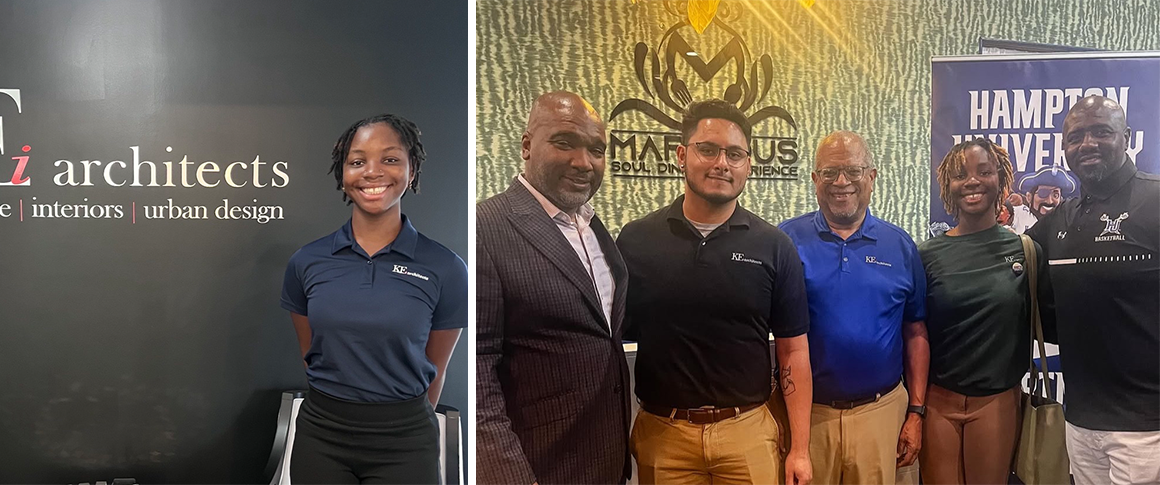We spoke with JaNyah Gholar, an architecture student at Hampton University, who shared her experiences pursuing licensure through the Integrated Path to Architectural Licensure (IPAL). From coursework to firm responsibilities, she shares advice for students interested in earning their license and pursuing a career within the profession.
What made you interested in pursuing a career in architecture?
I’ve always been fascinated by the relationship between the natural and unnatural environment—how the connection can be harsh, unnerving, and unpredictable, or calculated, harmonious, and blendable. I’m mostly interested in the latter: how unnatural elements like building materials can emulate the natural world, acting as extensions of their surroundings. My aunt Charmene was the first person to say that I should pursue architecture due to my imaginative thinking.
The blooming of these thoughts has a lot to do with where I grew up. Being raised in an extremely rural area constantly stricken with severe weather, I’ve seen homes and stores be forced to bend to the will of the elements, becoming run down and eroded after having survived storm after storm. I’ve experienced what it feels like to have to fully trust in the roof over my head to not cave in. So, what I’m most interested in is cultivating designs that work with the forces of nature, allowing for a mutual benefit between the building, the natural world, and the person inside.
As a student enrolled in an IPAL option, tell us a bit about your path to licensure. Are there any experiences (obstacles or achievements) you’ve faced so far that have shaped your journey?
My path to licensure started later than my peers. Being from a place with few architectural outlets for active work and the hardship of finding somewhere to live away from home at the time made finding a firm difficult. During this time, I questioned whether IPAL was meant for someone with my circumstances. But rather than sit in my despair, I began to really hone in on my reasons for wanting to be in the program and what it would mean for someone like me to be able to complete it.
Becoming licensed is something that I have always looked forward to since learning about it, and nothing would get in the way of my pursuit of it. So, I allowed my lack of an internship to be a driving motivator, pushing me to get better in my work in class so that I could hopefully gain one the following summer. Through this determinative thinking, I successfully gained an internship at a firm in an area where I could also live. So, if this program has taught me anything, it’s to stay patient and determined even through pain-stricken times.
How do you balance meeting licensure requirements and your coursework?
I would not have had the opportunity to pursue my current licensure path had it not been for the work I’ve done in school, so I always put my coursework above work assigned to me by my firm. This also means not biting off more than I can chew and communicating with my employer when my workload becomes overwhelming.
Having conversations like these helps in the long run, as I can have more experience in properly communicating my need for help in a professional setting, especially when different deadlines begin to run into one another.
Why is earning a license important to you? Are there any specific goals you want to achieve once you’ve earned your license?
Being a Black woman, I see little representation of people who look like me in the field. So, on a personal level, earning a license means that I can be that point of representation in another young Black girl’s life—someone she can see as herself when she gets older.
Regarding architecture specifically, I have become concerned with the way our current infrastructure is damaging the environment. So, I hope that obtaining a license will open doors for me to research more about technologies that can slow down the destruction and help the environment.
Do you have any advice for incoming IPAL students or students interested in pursuing a career in architecture?
My advice for incoming IPAL students and students interested in an architectural career is the same: Find your “why” for architecture and explore all angles of that why. Get as far left field in your thinking and in design, then turn right; never stop being curious.
For IPAL students specifically, when jumping right into the work field, you may find that your work at the firm may not align with your dreams for your architectural career.
This experience is about gaining professional knowledge in the early stages to use with your dreams later, but you have to hold onto and stay with them. Play and work with your ideals in your schoolwork, at home, whenever you can. Because when you finally achieve licensure, you have the power to professionally execute the amazing ideas you’ve come up with over the years—you just have to keep them in your head until it’s time.
